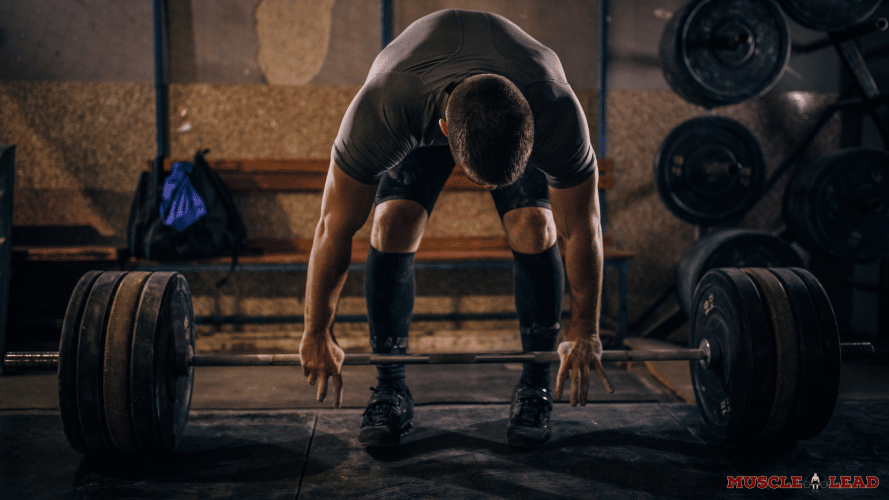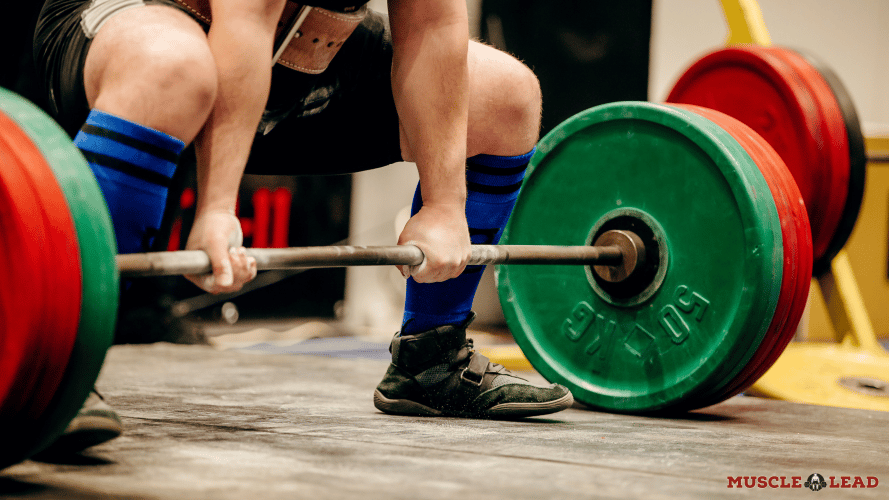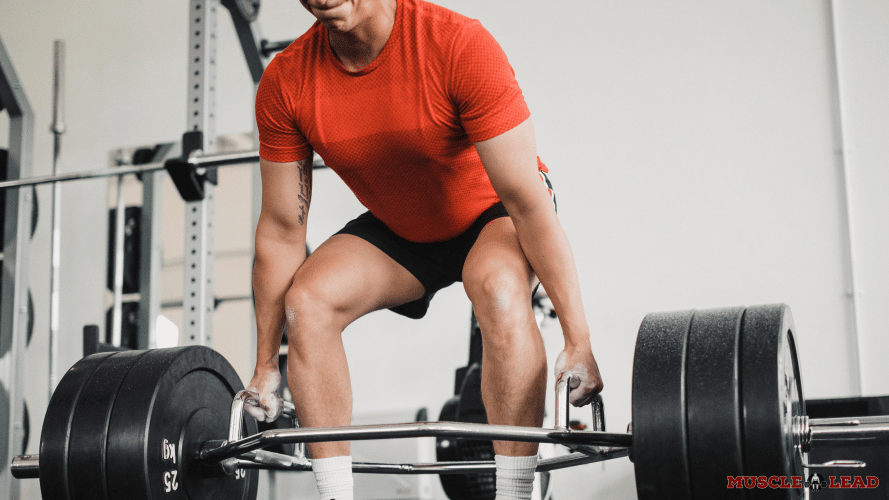Key Points
- First, you need to make sure that your arms are actually short. You can determine this through self-assessment and by measuring the length of your arms, legs, and torso.
- Although the way you deadlift will be different if you have short arms, some deadlift mechanics won’t change.
- Some fundamental deadlift principles remain the same, even if you’re deadlifting with short arms.
Some people are predisposed to be better at certain exercises. Their build allows them to naturally create better leverage and create more force in certain positions.
The deadlift is no different.
If you have a long torso with long legs and long arms, you are predisposed to be great at conventional deadlifts.
So what are the best tips for deadlifting with short arms?
- Use a partially rounded back
- Consider the sumo deadlift
- Try rack pulls and block deadlifts
- Build stronger quads
- Improve core strength
- Get horizontal to the floor
- Build stronger hip flexors
- Try trap bar deadlifts
We bring you more details on the 8 tips of how to deadlift with short arms. So let’s get started!
What is Considered Short Arms?
A lot of lifters will blame their “short arms” for their deadlift difficulties.
However, people toss that term very lightly. The length of the arms itself is not what plays so much role during the deadlift.
What matters is the length of the arms compared to the rest of your body.
For example, if you have short arms but your arms are proportional to the rest of your body, i.e. you also have short legs and torso, it won’t have a major effect on your deadlift mechanics.
However, if the length of your arms is short compared to the length of your legs and torso, well the bad news is, that could make the deadlift mechanics more difficult for you.
But first, you need to make sure that your arms are actually short. You can do then through self-assessment and by measuring the length of your arms, legs, and torso.
Check out the article for Deadlifting for Tall Guys: 8 Best Tips
Self-assessment
- Torso length: To measure the torso length, start from the hip bone (from the greater trochanter) and measure the length to the top of your head.
- Arm length: Start from the humeral head in your shoulder joint and measure the length to the tip of the middle finger.
- Leg length: Start from the same place you did during the torso measurement and measure the length from your hip bone to the ground.
Take the measurements of each segment and calculate what percentage of the overall height it represents. You can do that by dividing each segment with the value of overall height.
Now that you have the measurements, the references from the study done by Hales (2010) can help you determine whether you have short arms compared to the rest of your body.
If the measurements actually point out that you have short arms, keep reading. We made this article entirely for you.
| Segment lengths expressed as a proportion of the body | |||
| Average (%) | Above average (elongated) (%) | Below average (short) (%) | |
| Torso | 32 | >32 | <32 |
| Legs | 49 | >49 | <49 |
| Arms | 38 | >38 | <39 |
Deadlift Mechanics
In order to know how to adjust the deadlift to your needs, you need to understand the mechanics of a proper deadlift first.
Although the way you deadlift will be different if you have short arms, some deadlift mechanics won’t change.
So let’s take a look at what deadlift mechanics will stay the same, regardless of your arm length.
1. Arm and Feet Position
The length of your arms won’t affect your initial deadlift stance. The initial stance will be identical to the stance of lifters with longer arms. So, stand with your feet shoulder-width and grip the bar with your hands outside the legs.
2. Bar Over Your Mid-foot and Close to Your Shins
Before you even start with the lift, make sure that the barbell setup is right. Placing the barbell over your mid-foot will automatically bring the barbell closer to your shins.
This proper barbell setup ensures many things. First, it distributes the weight closer to your center of mass, which allows more vertical bar travel, maintaining good deadlift technique, and good force production.

Placing the barbell further away from your shins and in front of your foot will load your body more anteriorly. The anterior load can negatively affect your deadlift technique because it requires more rounding in the back during the initial stage of the deadlift.
Also, you won’t be able to produce as much force with your feet and the bar won’t travel as vertical. This makes the deadlift less biomechanically efficient and unnecessarily harder.
3. Shoulder Blades Directly Over the Bar
As you get into a deadlift stance and grip the bar with your hands outside your thighs, make sure your shoulder blades rest directly over the barbell. This means your shoulder joints will be slightly in front of the barbell.
However, if you imagine drawing a straight line from your shoulder blades to the floor, the barbell should be directly on that line. This position allows you to pull vertically and better engage your upper back muscles.
8 Tips for Deadlifting with Short Arms
1. Use a Partially Rounded Back
Let’s face it, if you have short arms your deadlift won’t be a textbook example of how to deadlift. That doesn’t mean you are not able to deadlift with the correct form, but that your deadlift will look slightly different.
The most noticeable difference will be the rounding in your upper back. Rounding in your upper back isn’t dangerous and there is no high risk of injury. Rounding in your lower back might be and can lead to injury. Especially at heavier loads. So, if you end up rounding your back, make sure it’s in your upper back.
Upper Back Pain While Deadlifting? Check out these fixes.
However, rounding your upper back often occurs when your torso is in a more upright position. This will naturally round your upper back in order to be able to grip the barbell. If you put your torso more horizontally to the floor, your back won’t round as much.
Also, to make sure that your rounding in the upper back is “justified”, compare your lightweight deadlifts with deadlifts at heavier loads. I
f your back rounds during the heavier loads only, this can indicate that your rounding is due to inadequate upper back strength. And not because of your short arms. So work on your upper back strength in order to fix it.
2. Consider the Sumo Deadlift
Considering your body structure, sumo deadlift might feel the most natural for you.
The sumo deadlift is performed with feet wider than shoulder-width apart and slightly pointing out. Also, you are gripping the bar with arms inside your thighs and with the torso in a more vertical position. This style of deadlift puts more emphasis on your glutes and quads, and less on your lower back.
What are the Best Alternatives to Sumo Deadlift
Because of the more upright ascend and less degree of hip extension than in the conventional deadlift, the arm length doesn’t play as much role in the sumo deadlift.
By having a wider stance, it’s easier for you to make up for shorter arms by getting deeper with your hips.

However, sumo deadlift requires a high level of technique, so expect a couple of months of adaptation and a learning curve to get competent in it.
3. Try Rack Pulls and Block Deadlifts
If you are not a fan of sumo deadlift, try partial deadlifts. This can be either rack pulls or deadlifts performed from blocks that will elevate the bar.
The higher bar position allows you to compensate for the lack of arm length and because the bar is already closer to your arms, it allows you to get into a better position.
Benefits of the Block Pull Deadlift: A Complete Guide
Also, the higher bar position allows you to keep your torso more upright during the initial pull. This will put less stress on your back and reduce the rounding.
But that’s not the only benefit that rack pulls and block deadlifts have. They can be a great way to build strength too. These kinds of lifts where the barbell starts at knee level or slightly below offer almost the same strength benefits as the full deadlift.
These lifts are often used for improving the pulling strength and adding more weight to the bar for deadlifts.
So they have a great potential for giving you the same strength benefits without the biomechanical hurdles the short arms give you during the deadlift.
4. Build Stronger Quads
If you want to do a conventional deadlift with short arms, you will have to bring your hips extra low to compensate for the lack of arm length. This starting position will require a lot of quad work in the initial stage of the deadlift.
So in order to take advantage of more quad involvement, make sure they are strong. Add into your workout exercises that are quad-specific.
The best way to do that are the paused high bar squat, and the paused front squats. At the bottom position of the squat, pause the weight and hold it for a few seconds and then drive up. This will emulate the demand your quads will have to perform during the conventional deadlift with low hips.
5. Improve Core Strength
The strong abs and core work won’t make deadlifting with short arms automatically easier. However, this will keep your back safe which is important.
Deadlifting with short arms often causes your back to round. Having a strong core will stabilize your spine and keep it safe during the lift.
Good exercises for that are the bird dog, dead bugs, and ab wheel rollouts. These are anti-extension exercises that will strengthen your core and help keep your spine stable during the lift.
6. Get Your Torso more Horizontal to the Floor
In order to get your shoulder blades directly over the bar, having short arms will naturally pull you more forward. This means that during the starting position of the deadlift, your torso will be in a more horizontal position to the floor.
This position will allow you to grip the barbell without rounding your upper back as much.
However, the more horizontal torso also means that more work will be needed from your erectors. So make sure you have strong erectors and a strong lower back.
If you have a problematic low back, this might not be the best position for you since it can put too much pressure on your low back and flare it up.
7. Build Stronger Hip Extensors
If you decide to deadlift with your torso being more horizontal, it will demand more work from your erectors, your hamstrings, and glutes.
The more horizontal torso position requires a greater path the hips have to travel, so this kind of deadlift will require more strength from your hip extensors – the glutes.
8. Try Trap Bar Deadlifts
Compared to the barbell deadlift, the trap bar deadlift places weight closer to your center of mass and puts your body in a more natural position.
By griping the trap bar with your arms next to your body, instead of in front of you as during a barbell deadlift, the weight is more evenly distributed and puts less pressure on your low back.
Also, this allows you to have a more upright torso position and a greater degree of hip range of motion.

The greater hip range of motion allows you to get more easily into a horizontal position and overcome the lack of arm length without putting more stress on your lower back.
Trap Bar Deadlift vs Front Squat – Pros and Cons
FAQs
For a standard deadlift, yes. If you deadlift from the floor, that means that the range of motion of the lift will be greater. The greater range of motion means more muscle work and greater hypertrophy and strength potential.
Final Thoughts
No matter anatomy, deadlifting with short arms has small changes. These include having the same feet and arm starting position, starting with the bar over your mid-foot and close to your shins, and keeping the shoulder blades directly over the bar.
The rest of the deadlift will probably look different if you have shorter arms. And even though shorter arms put you into a disadvantageous position for deadlifting, it doesn’t mean you are screwed. By incorporating these tips into your training, you can become a better lifter.
Also, not all is lost. You might be envious of your friend’s long arms because they make him the better deadlifter, but so will he of yours during the bench press. His long arms will make him inferior compared to you. So know how to pick your battles.
Just because you are at a disadvantageous position in some exercises, doesn’t mean that you are screwed overall.
More About Deadlifts:





